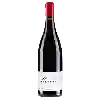
Domaine Mathieu & Camille LapierreJulienas
In the mouth this red wine is a with a nice freshness.
This wine generally goes well with pork, poultry or veal.
The Julienas of the Domaine Mathieu & Camille Lapierre is in the top 10 of wines of Juliénas.
Taste structure of the Julienas from the Domaine Mathieu & Camille Lapierre
Light | Bold | |
Smooth | Tannic | |
Dry | Sweet | |
Soft | Acidic |
In the mouth the Julienas of Domaine Mathieu & Camille Lapierre in the region of Beaujolais is a with a nice freshness.
Wine flavors and olphactive analysis
On the nose the Julienas of Domaine Mathieu & Camille Lapierre in the region of Beaujolais often reveals types of flavors of cherry, earthy or blackberry and sometimes also flavors of minerality, red fruit or strawberries.
Food and wine pairings with Julienas
Pairings that work perfectly with Julienas
Original food and wine pairings with Julienas
The Julienas of Domaine Mathieu & Camille Lapierre matches generally quite well with dishes of pasta, veal or pork such as recipes of spaghetti with salmon, pasta with veal stock sauce or meatloaf with lovage (perpetual celery).
Details and technical informations about Domaine Mathieu & Camille Lapierre's Julienas.
Discover the grape variety: Gamay noir
Gamay is a Burgundian grape variety that has existed since the 14th century. For fear of competition with the pinot noir of Burgundy, gamay was finally uprooted and planted in the Beaujolais region, from Mâcon to Lyon. These siliceous and granitic soils suit it perfectly, and it gives its best here. But it is also planted all over France, such as in Lorraine, in the Loire Valley, in Bugey, in Savoie and in Auvergne. Gamay is early and very productive and needs to be limited so that quality prevails over quantity. Short winter pruning of the shoots and high density of vines per hectare are the methods that allow it to produce very fruity, fresh and greedy red wines. Gamay is also very popular in red wine futures, and produces wines from the Beaujolais region with very interesting character and ageing potential. The AOCs Crémant-de-Bourgogne, Mâcon, Anjou, Touraine, Rosé de vallée de la Loire, Côtes-d'Auvergne, Saint-Pourçain, Bugey, Gaillac, Côtes du Luberon... and many vins de pays are proud of it. Today, about 36,000 hectares of Gamay are cultivated in France, including 22,000 hectares in Beaujolais.
Last vintages of this wine
The best vintages of Julienas from Domaine Mathieu & Camille Lapierre are 2017, 2018, 2016
Informations about the Domaine Mathieu & Camille Lapierre
The Domaine Mathieu & Camille Lapierre is one of of the world's greatest estates. It offers 19 wines for sale in the of Juliénas to come and discover on site or to buy online.
The wine region of Juliénas
Juliénas is an appellation covering wines produced from vineyards in the northern Beaujolais region of eastern France. The red wines of Juliénas, made from Gamay grapes, often have Spicy, Floral">floral and red fruit characters. They tend to be heavier than those of the neighboring appellation of Saint-Amour and some of its southern counterparts. Despite this, Julienas wines tend to have a shorter shelf life, and are best drunk no later than two or three years after the Vintage.
The wine region of Beaujolais
Beaujolais is an important wine region in eastern France, famous for its vibrant, Fruity red wines made from Gamay. It is located immediately South of Burgundy, of which it is sometimes considered a Part, although it is in the administrative region of Rhône. The extensive plantings of Gamay in this region make Beaujolais one of the few regions in the world that is so concentrated on a single Grape variety. Pinot Noir is used in small quantities in red and rosé wines, but in the name of regional identity, it is being phased out and will only be allowed until the 2015 harvest.
The word of the wine: Oenologist
Specialist in wine-making techniques. It is a profession and not a passion: one can be an oenophile without being an oenologist (and the opposite too!). Formerly attached to the Faculty of Pharmacy, oenology studies have become independent and have their own university course. Learning to make wine requires a good chemical background but also, increasingly, a good knowledge of the plant. Some oenologists work in laboratories (analysis). Others, the consulting oenologists, work directly in the properties.














